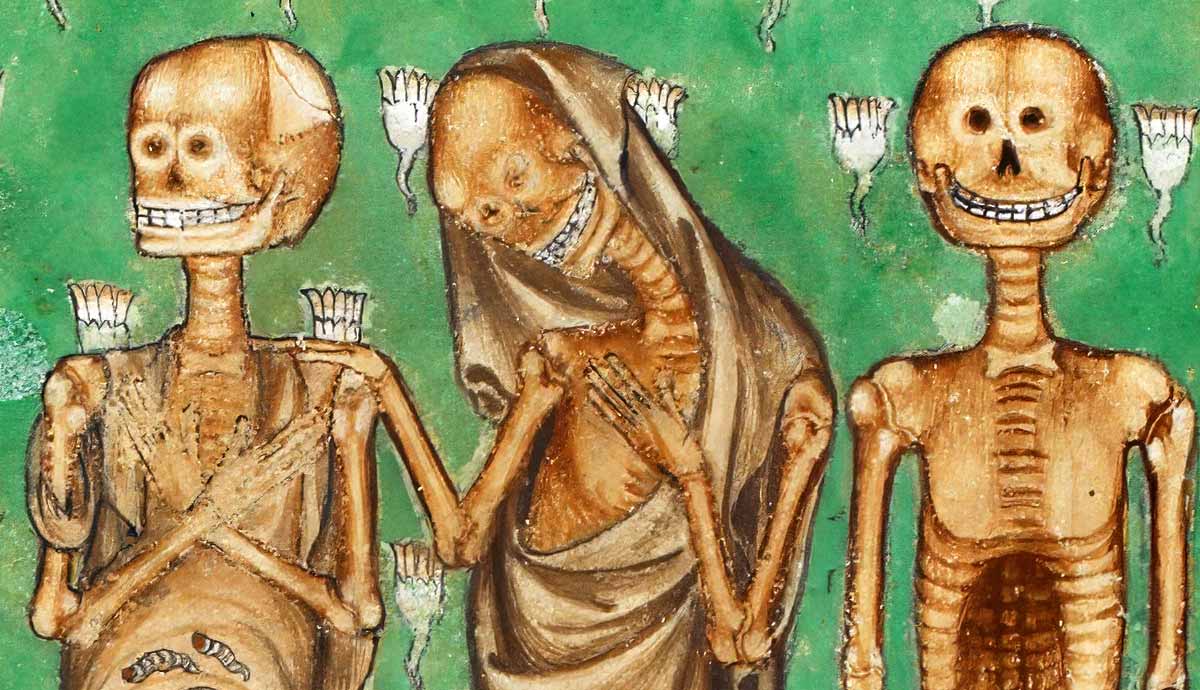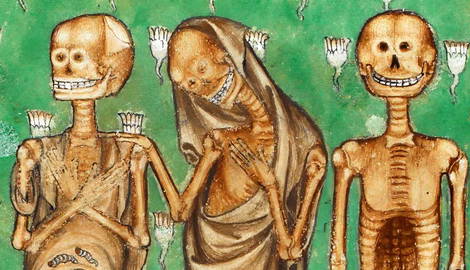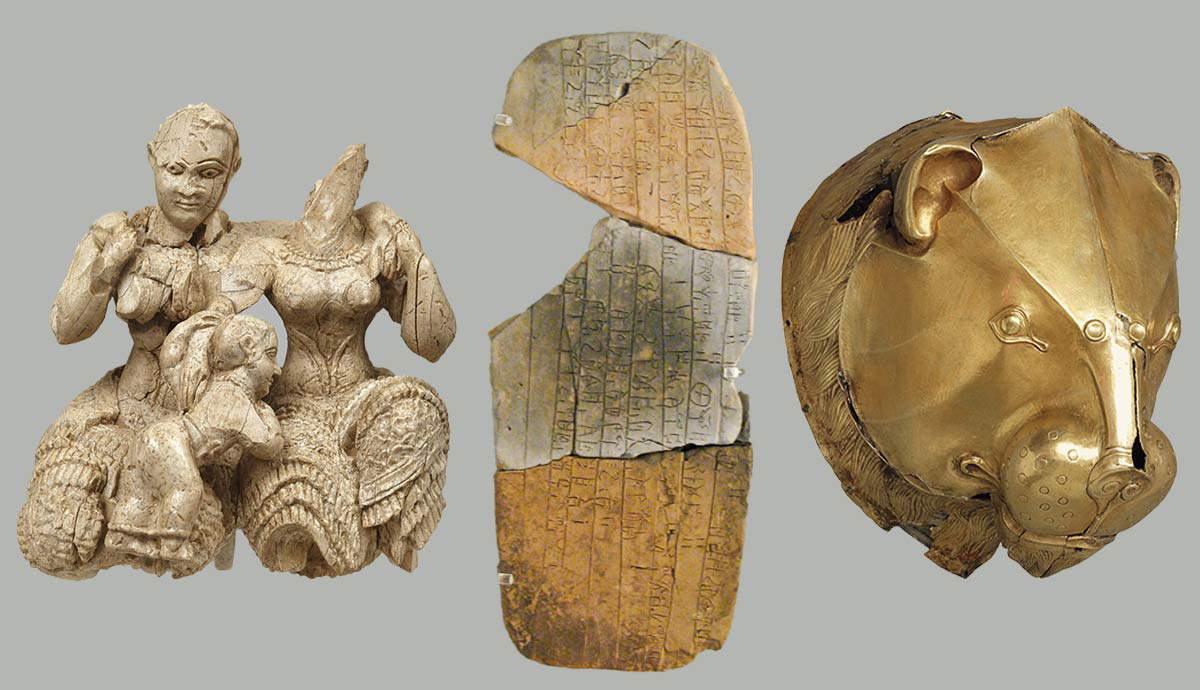
The Vikings believed in life after death, but also that people could get caught between life and death. Returning as a revenant usually happened to evil people who clung to life for their own vile purposes. These zombie-like creatures were called, among other things, “draugr,” “aptrganga” (after walkers), or “haugbui” (mound-dwellers). They had superhuman strength and terrorized communities until their bodies were disposed of in such a way as to prevent them from rising again. Below are some of the surviving stories of the undead from the Icelandic sagas, plus a look at how the Vikings buried suspected revenants to stop the dead from rising.
Grettir the Draugr Slayer

Grettis saga is one of the Icelandic sagas written down in the 13th or 14th century but talks about events that supposedly occurred in the 10th or 11th century. It tells the story of Grettir, who was determined to become a monster slayer, like the pagan warriors of old, in a swiftly Christianizing Iceland.
The first creature that Grettir fights in his quest to become a hero is the draugr of a man who used to be called Kar the Old. He is now protecting the treasure in his burial mound from looters. Grettir kills the draugr with a sword and takes treasure from his burial mound, including a fine sword.
Later in life, Grettir faces another draugr, who had been a strong but ignorant herdsman named Glamr. He was known to do things such as ignore Yule traditions and demand his wife serve him meat when he should be fasting. One day, around Yule, he went out into the snow to deal with a wight causing problems in the area. While he seems to have driven the creature off, he lost his own life in the process. The townspeople were unable to retrieve his body, so he did not receive a proper burial. Not long after, many members of the community encountered the dead man abroad, confirming that he had become a draugr. His level of mischief increased over time, destroying houses with his bare hands, sending cattle mad, and killing men by crushing their bones.

Eventually, Grettir appears on the scene determined to face Glamr despite warnings from the locals and the death of his horse. When the two eventually confront one another, Glamr is described as an enormous figure stinking with the decay of death. His nose is falling off, his skin is dead and green in places, his nails and hair have continued to grow, and he has dead red eyes. The two wrestle, but Grettir is no match for the strength of the draugr who uses his nails as knives.
During the fight, Glamr curses Grettir by stating that from that moment forth he will only have ill luck, he will never get stronger, only weaker, and that Grettir will forever be haunted by the eyes of the draugr. This distraction allows Grettir to grab his sword and behead the draugr. The body was then burned, and the charred bones were buried in a remote spot far from the village. But Glamr’s curse came to pass and Grettir would eventually die as an outlaw.
Thrainn the Undead Witch King

Hromundar saga Gripsonnar was also written in the 14th century and relates events reported to have occurred at the start of the 11th century. The hero Hromundr goes into battle against an ex-berserker warrior and an undead witch king called Thrainn, who is a draugr. He was previously a Gallic king and used sorcery for his evil ends in life. Thrainn had previously killed 420 men singlehandedly, including Saemingr, the legendary first king of Norway, with an enchanted sword called Mistletoe. He reportedly entered his burial mound while still alive, actively choosing to become undead.
Sailing to Gaul with the express purpose of entering Thrainn’s burial mound, Hromundr was the only man of a team of 60 brave enough to enter and attempt to kill it. He finds the king sitting in a chair, and he is described as ugly, with blue skin, and clad in gold. Hromundr steals the king’s sword and then challenges him to fight, but the weary draugr is uninterested in the battle. After much goading from Hromundr, Thrainn rises to the conflict but insists that they wrestle since he is unarmed without his sword.
The draugr uses his fingernails as talons and scratches the hero’s neck but is overpowered. Before being slain, Thrainn warns Hromundr of the dangers of prioritizing wealth over the truly important things in life. Unmoved, Hromundr beheads the draugr with his own sword and then sets his body on fire. Later, when his companions ask him what happened, Hromudr suggests that Thrainn died by choice.
Hrappr the Greedy

Laxdoela saga was written in the 13th century and tells the story of the people of the west of Iceland between the 9th and 11th centuries. Hrappr was a Hebridean man with a Scottish father and a Hebridean mother. He was forced to immigrate to Iceland after his violent temper caused him trouble in his homeland. He set up a homestead and fought with his neighbors until he was bedridden in old age. He requested that he be buried in the main room of his house where he could continue to watch over his home.
After death, he did just that, as a draugr. He terrorized everyone who remained on his farm until they fled, and he started terrorizing the neighbors. This caused the neighbors to go to the local leader for help. A plan was hatched to dig up the body and move it away from the farm. While this caused a reduction in Hrappr’s haunting activities, he still eventually sent his son mad so that he killed himself.
Next, another kinsman set sail to Iceland with the intent of taking over the farm. But as they were sailing, their boat was struck by an unnatural storm, and all but one man was killed.
The farm remained deserted for several years until a man named Olafr bought it at a huge discount. It was not long after he arrived that Hrappr started haunting the new household. Olafr saw the draugr himself and threatened him with a spear, but Hrappr just grabbed the spear and sank into the earth. The next morning, he was dug up again, and his body had not decomposed, and he had the spear blade with him. This time they burned the body and scattered the ashes at sea. Hrappr was not seen again.
Thorolf Lame-Foot the Undecayed

In the Eyrbyggja Saga, written in the 13th or 14th century, Thorolf Lame-Foot is another draugr. In life he was known to be an evil man who took advantage of his neighbors and even dabbled in black magic. One night he sat in his high seat all evening and refused to rise as others left. In the morning, he was found in the same high seat, dead, eyes open like the living dead. Everyone was afraid to walk past his corpse until his eyes were closed.
When his son Arnkel came to remove the body, he approached it from behind to avoid eye contact and then covered the head with a cloth. He then had a hole cut in the wall to carry his father out. Arnkel stayed in his father’s home for three nights after his death, but nothing ill happened.
But after Arnkel left, the locals believed that Thorolf was abroad and thought it best to be home before dusk to avoid encountering him. Moreover, the oxen that had been used to drag Thorolf’s body to its final resting place went wild and howled themselves to death. Cattle that went near his grave suffered a similar fate. Many shepherds reported being chased by Thorolf. There eventually came a day when a herdsman and his entire flock went missing. The next day, the people found the body of the herdsman with every bone in his body broken. Many members of the household fled, and many died, but they were later seen in the company of Thorolf, also undead.

After the perilous winter ended, Thorolf’s son decided to retrieve and move his father’s body to end the chaos. When they retrieved it from its burial mound, they found that the body had not decayed but looked evil. Again, the body was heavy, and the oxen used to pull the cart to move the body quickly went mad. As a result, they had to bury him closer than they had wished, at a place henceforth called Half-Foot’s Head. For protection, they raised an enormous wall around the burial mound, so high that fowl could not pass over it, trapping him inside.
This dealt with the draugr for a time, but after his son Arnkel died, Thorolf was found abroad again. The locals retrieved his body, which was still undecayed, and set it on fire, though it took an eternity to burn. They then scattered his ashes at sea, finally ridding the community of the undead scourge.
Thorgunna and the Draugr Epidemic

Later in the same saga, Thorgunna suffers a similar fate. Following a storm in which it reportedly rained blood, only Thorgunna was not able to wash the red marks away. This quickly led to her falling ill. Knowing that she would soon die, she bequeathed all her worldly wealth to Skalholt Church, where she also wanted to be buried. The only exception was her bed linens, which she wanted burned. But when she died, the man responsible for carrying out her wishes, Thorod, gave the bed linens to his wife at her request.
As a group of men was transporting Thorgunna’s body to its burial place, a great storm beset them and they had to stop, taking the corpse into the house of a local couple overnight. As the men were speaking with their host and warming themselves in front of the fire, they heard sounds in the kitchen. When they went in, they saw Thorgunna’s corpse, completely naked, setting a meal for them all. Considering it dangerous to refuse the draugr’s hospitality, they blessed the meal with holy water and ate. Thorgunna returned to her corpse box and seems to have been buried without further incident.
When the men delivering her body returned home to Frodis-Water, people began to fall sick and die in the same way as Thorgunna. It started with a herdsman, who died in his bed in the same manner and was buried at the local church. His draugr attacked Thorir Wooden-Leg when he went to use the outhouse, and he later died in bed in the same way. He was buried at the local church, but his draugr was later seen abroad with the herdsman. Another six men died in short succession.

There was then a disturbing incident in which a seal draugr entered the home of Thorod. The seal was repeatedly beaten but just kept coming back until its head was completely smashed in. It was only after this that Thorod finally burned Thorgunna’s bed linens.
Further hauntings and deaths followed. According to the saga, at the start of this series of incidents, Frodis-Water had a population of 37 serving folk, but following these events, 18 were dead, five fled, and only seven remained.
Revenant Burials and Graves

When the Vikings were pagans, cremation followed by burial was the most common way to honor the dead. It was believed that an element of human vitality remained attached to the body after death, and burning was a way to detach it. Placing something in the ground was a way to move it between worlds, and burial mounds were seen as gateways between life and the afterlife. Reflecting these beliefs, according to Odin’s Law, anything burned on a funeral pyre or personally placed into the ground could be taken into the afterlife (Ynglinga saga, 8).
When the Vikings converted to Christianity, cremation was abandoned as it was believed to be important to maintain the body’s integrity for eventual resurrection. This undermined some of the rituals the Vikings relied on to prevent revenants and may explain why stories of them were so common in Christian Iceland.
Consequently, people had to resort to other strategies to prevent the undead from rising. They might block the eyes, mouth, and nostrils to limit their senses and cut fingernails to remove these potential weapons. Bodies were sometimes carried out of a hole in the wall, rather than a door, to make it difficult for them to find their way back. For the same reason, some bodies were buried in remote and distant locations. Stones were placed on the body to prevent rising, and walls were built around the burial mound to trap the undead.

Decapitation and burning were a last resort as it involved damaging the body. For example, in the Fljotsdoela Saga, a troublesome giant was slain and beheaded. Once his body stopped contorting, they placed his head between his legs and burned his body to prevent him from walking again. It may be that the Vikings believed the head had a special supernatural significance. When Mimir was killed and beheaded by the Vanir gods, Odin was able to magically reanimate his head.
While revenant burials are often mentioned in the sagas, they are harder to identify in the Norse archaeological record. While there is plentiful evidence for decapitated burials, it is unclear whether this was done to prevent the dead from rising or for other reasons, such as to punish a criminal or mark someone out as a slave. There are also examples of weights and weapons placed in graves, which may have been meant to prevent the dead from rising.

One potential example of a revenant grave may come from a 10th-century Danish cemetery at Bogovej. A female, aged 30-40, had been decapitated and her head placed between her legs. The grave contained jewelry that seems to have been displaced from its original position, which may suggest that she was buried normally, and then dug up, decapitated, and reburied.
Further evidence may come from a bronze runic plate, called the Ulvsunda sheet, found in Uppland, Sweden. It has an inscription on both sides, no bigger than a fingernail, composed of 30 tiny runes. It seems to be an incantation to prevent the dead person with whom it was buried from rising. A reconstruction of the inscription may read “Don’t be over-lively out of the grave ghost, may the evildoer get woe.” Similarly, the Nørre Nærå Kirke Runestone also seems to contain a spell to keep the dead in their graves.
While the surviving evidence is often challenging to interpret, it is clear the undead were considered a serious threat in Viking society. Laws existed prohibiting any actions to raise the dead.
Selected Bibliography
Gardela, L. (2011) “Buried with Honor and Stoned to Death? The Ambivalence of Viking Age Magic in Light of Archaeology,” Analecta Archaeologica Ressoviensia 4(2009) 339-375.
Guerreiro F. (2003) Stranded in Midgardr: Draugar Folklore in Old Norse Stories, University of Oslo.
Tozzi, A. (2023) Norse Burial Practices and Medieval Fear of Revenants in the Ragnarok Saga, University of North Texas.










